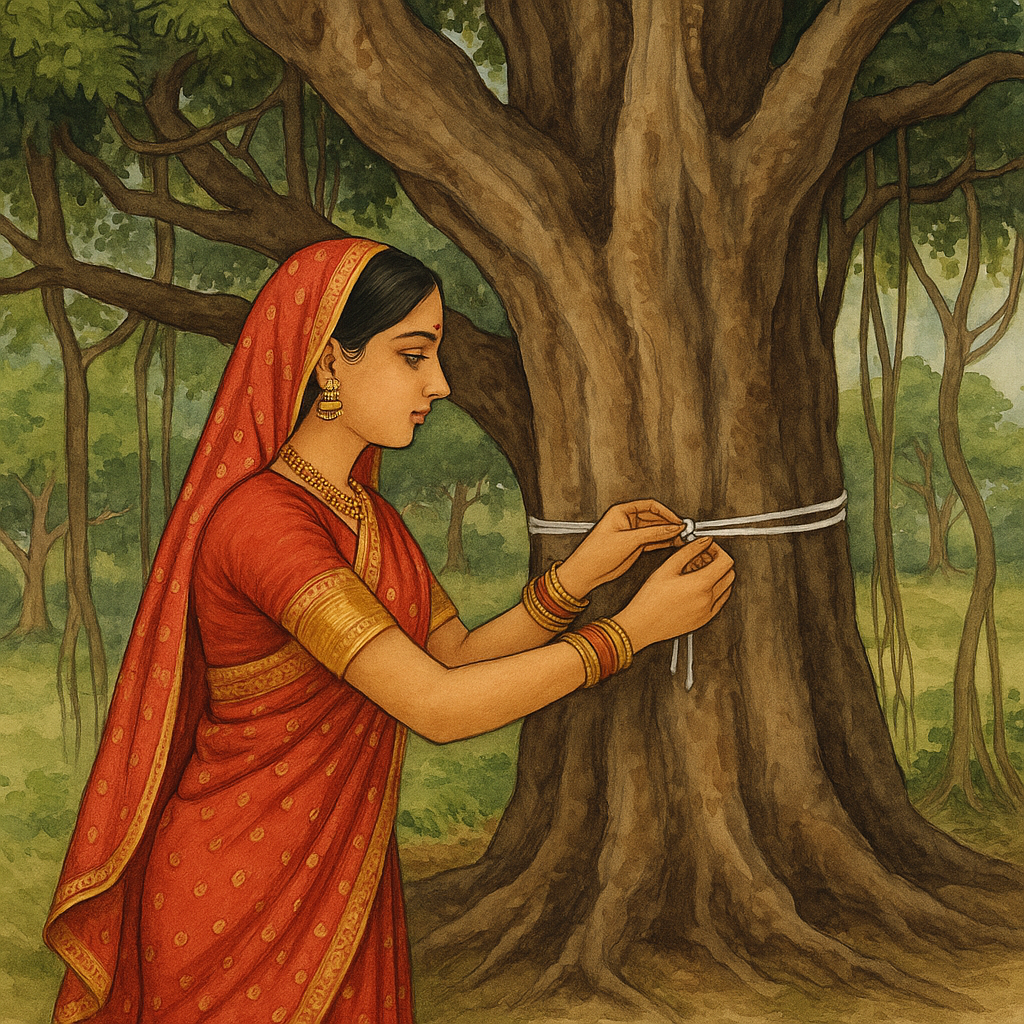
Sacred Secrets of Vat Savitri Vrat in North India
Introduction: A Sacred North Indian Tradition
Vat Savitri Vrat, deeply rooted in North Indian Hindu tradition, is observed primarily in Uttar Pradesh, Bihar, Madhya Pradesh, Rajasthan, and parts of Delhi. This sacred fast, observed on Jyeshtha Amavasya, is dedicated to Savitri, the epitome of feminine strength and devotion, who brought her husband Satyavan back from the jaws of death. The observance of this vrat combines nature worship, Vedic rituals, and seasonal harmony, forming an integral part of eco-spiritual Hindu living.
Know more about the story of vat savitri
Pre-Vrat Preparation (Purva Vidhi)
Women begin preparing days in advance:
1. Cleaning and sanctifying the puja space
2. Procuring fresh Vat Savitri Vrat Samagri: black gram (chana), new red cloth, bamboo basket, mango leaves, sacred red thread (mauli), sindoor, haldi, flowers, fruits (especially banana, mango, coconut), coins, diya, ghee, dhoop, and sweets called "Bargad"
3. Soaking 12 kala chana the night before
4. Making Athvai — small pairs of flour-based offerings
5. Preparing the Bargad sweet from jaggery and flour, signifying rooted energy and feminine nourishment
This stage reflects the satvik preparation of the self and space, aligning the devotee's inner intention with outer ritual purity.
Morning Rituals and Sankalp (Vrat Sankalp Vidhi)
On Jyeshtha Amavasya morning:
Women bathe early at sunrise, often in a sacred river or with Gangajal at home. They wear new or clean red/yellow sarees, symbolizing auspiciousness and fertility. A tilak of haldi and kumkum is applied on the forehead. The devotee then sits facing East and takes the Sankalp (vow) by reciting:
सावित्री व्रते अहं मया पतिव्रता-सुख-झाय-कामाय्य-कीर्तार्थां पतिनां च सुखाभाग्याय साधन्यार्थमावाप्न्नार्थं च काम्यने निर्वर्तितां करिष्ये।
Translation: "I observe this Vat Savitri Vrat with full devotion, for the wellbeing, longevity, and prosperity of my husband, with the inspiration of Savitri."
Tree Worship (Vat Vriksha Pujan)
The central ritual takes place under a Vat (banyan) tree:
The tree is swept clean, and a square altar (vedi) is made with kumkum, haldi, and rangoli. The base of the tree is decorated with flowers and mango leaves. Women tie the kachha soot (white thread) 7 or 12 times around the tree while walking around it, symbolizing the binding of longevity and marital commitment. They further tie 7 strands of mauli (red thread) around the tree and wear it around their neck as saubhagya sutra.
Offerings placed at the base include:
Chana (fertility and nourishment)
Athvai (dual unity, symbolic of couplehood)
Coins (Lakshmi and prosperity)
Coconut (wholeness and divine protection)
Bargad sweets (offerings of life)
The following mantra is recited during circumambulation:
वटास्या नमस्टकाय या सावित्री पतिव्रता |
चन्द्रां शाश्वती चैव कीर्ता पतिनां च नमामी |
Translation: "As Savitri gained her husband from Yama, may I too receive strength, fortune, and long marital life."
After circumambulation, women light a diya with ghee and offer dhoop. Bhog (offering) of sweets, fruits, coconut, and water is made. The diya is left at the base of the tree till it extinguishes, symbolizing the offering of light to the universe.
Donation (Dana)
Women donate the decorated bamboo basket containing: Chana, Seasonal fruits, Coconut, Sweets, Shringar items, Bamboo hand fan, to a married Brahmin lady or to sister-in-law or married daughter, symbolizing the sharing of saubhagya (marital bliss).
Analysis of Ingredients and Nature Symbolism
Vat Tree: Represents longevity, resilience, and the cosmic shelter of life — sacred to Brahma, Vishnu, and Shiva.
Chana: Fertility and food grain of endurance. It is believed that Yama returned the life force (Aatma) of Satyavan to Savitri in form of 12 black gram (kala chana)
Coconut: Universally sacred, represents seed, life, and wholeness.
Mauli Thread: Represents time cycles, blessings, and karmic bonds.
Kachha Soot: As per the mythology, Savitri had tied the toe of Satyavan to the Vat tree with Kachha Soot to protect him from Yama
Bamboo Items: Biodegradable, sattvic, and symbolize simplicity and purity.
Bamboo Fan: As per mythology, Savitri fanned the body of Satyavan with a bamboo fan and that air helped him in waking up after getting his life force. Logically, it makes sense to use and donate fan when the summers are at their peak.
Bargad Sweet: Made of jaggery and flour — denotes rooted sweetness and nourishes the symbolic energy of the ritual.
Conclusion: A Ritual of Dharma and Devotion
Vat Savitri Vrat in North India is not just a religious fast — it’s a deep ecological and spiritual ritual. From the banyan tree to bamboo baskets, every element is rooted in nature-worship, seasonal alignment, and Vedic symbolism. The ritual celebrates feminine strength, dharma, and love, teaching modern society the timeless wisdom of balance between material life and spiritual duty.
FAQs: Vat Savitri Vrat in North India
1. What is Vat Savitri Vrat?
It is a Hindu fast observed by married women for their husband's long life, inspired by the devotion of Savitri.
2. When is it observed?
On Jyeshtha Amavasya (new moon) in North India.
3. What is the main ritual?
Worshipping the banyan (Vat) tree, tying red thread around it, and praying for marital well-being.
4. What are key items used?
Chana, red thread, coconut, fruits, bamboo basket, fan, sweets, and haldi-kumkum.
5. Why is the banyan tree important?
It represents longevity, strength, and protection — ideal for marital blessings.
6. Who receives the daan (donation)?
A married Brahmin woman or a married daughter/sister-in-law is gifted a bamboo basket of puja items.
7. Can unmarried girls do this vrat?
Traditionally it’s for married women, but some girls observe it for future well-being.
8. What food is consumed?
12 soaked black gram (chana) are swallowed without chewing, and a sweet called “Bargad” is offered.
